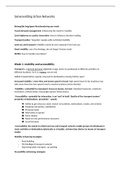Samenvatting Urban Networks
Belangrijke begrippen/kernboodschap per week
Travel demand management: influencing the need for mobility
Cycle highways as a policy innovation: how to influence decision-making
Transport justice: ‘forgotten’ people with no/limited mobility
Land use and transport: Mobility cannot be seen separate from land use
Smart mobility: use of technology, do not forget ‘human needs’
DMDU: how to handle uncertainty?
Week 1: mobility and accessibility
Transport is a derived demand (afgeleide vraag), desire to participate in different activities on
different locations. So it is a means, not an end.
Added transportation capacity may lead to destinations moving further apart.
Increased mobility = more time and money spent in travel: high speed travel to far locations may
take more time then low speed travel to nearby locations (urban density).
! Mobility = potential for movement. Focus on means, not end. (standard measures, maximum
movement, vehicle needs, encourages sprawl, limits choice).
! Accessibility = potential for interaction. Is an ‘end’ in itself. Quality of the transport system *
proximity of destinations. (proximity * speed).
Ability to get what you need: choice! (of activities, destinations, modes, arrival time)
Maximise interaction, satisfaction
Personal needs
Alternative to sprawl
More choices
Need for new performance measures
Social inclusion
! Accessibility: the extent to which land use and transport systems enable groups of individuals to
reach activities or destinations (physically or virtually), at times they desire, by means of transport
modes.
Mobility enhancing strategies
- Road building
- ITS (intelligent transport systems)
- Improving public transport, car pooling
Accessibility enhancing strategies
, - Land use strategies (proximity)
- ICT (virtual mobility, no need to travel)
- Social inclusion policies
- Time management policies (e.g. opening times)
Mobility limiting strategies
- Pricing (road, parking, taxes)
- Road restrictions
Measuring accessibility
Indicator: operationalisation of concept.
Infrastructure based measures
1. Supply based measures: accessibility expressed in characteristics of transport infrastructure
and transport systems (e.g. total length of road network, connectivity of trains)
2. Use based measures: accessibility expressed in the performance of transport infrastructure
and transport systems (e.g. vehicle hours lost (zoveel minute reistijd verloren)
Easy to measure and understand and build policy on.
BUT: simplistic, not human focussed, focus on transport system
Spatial based measures
1. Contours: e.g. number of jobs within 30 minutes (circle around initial location)
2. Relative accessibility: e.g. travel time to nearest hospital
3. Integral accessibility: mean travel time to all health clinics in region
BUT: makes for discussions about best location, how large to make the region,
preferences.
4. Potential accessibility measures/gravity based measures: the further a location is away, the
less weight is assigned to it.
Closer is better
Uses exact locations
Easy to understand
BUT: according to this measure, firms should all locate in one central area, leading to
competition for small amount of employees nearby,
leading to rising land prices and stress on infrastructure.
Therefore, some sort of spreading is needed.
Person based measures
1. Space-time opportunities: how many places can you reach
in a certain amount of time?
Depends on capabilities, is very personal.
Economic measures
1. Generalised costs (GC): accessibility expressed in travellers costs, all aspects are monetised
(e.g. time, comfort, actual travel costs) results in a total sum.
Most used in practice, has most advantages (easy to understand, communicate,
operationalise and high policy relevance)
, 2. Longsum measures: accessibility expressed in economic utility that an individual assigns to
the ability to reach certain activities that is the net effect of costs and benefits. So measures
the ‘willingness to pay’: benefits v.s. costs. Represents the maximum utility that an individual
can get for his money and time.
Economic benefits of accessibility
Why firms are more productive in cities: agglomeration effects
But in the Netherlands smaller agglomerations. Oplossing:




